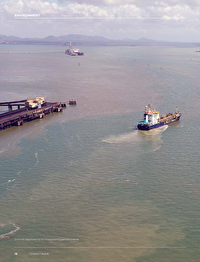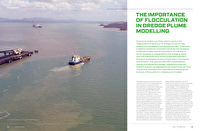Field measurements have shown that in the marine environment, fine-grained sediment that is naturally in suspension and finegrained sediment suspended by dredging are typically present as aggregated particles known as flocs (Manning, 2004; Smith and Friedrichs, 2011; Beecroft et al., 2019). The process of flocculation in marine environments is most likely to occur due to particle collisions from turbulent motions meaning that increased flocculation occurs when suspended sediment concentrations (SSCs) are higher and moderate turbulence is present (Winterwerp and van Kesteren, 2004). Therefore, the localised elevated SSC and increased turbulence that can occur during dredging has the potential to result in flocculation. However, aspects of dredging that result in very high turbulence such as pumping sediment through pipelines, have the potential to break up existing flocs either down to smaller flocs or individual particles.
Measured data collected in the Port of Gladstone have shown that flocs were present in a plume generated by a trailing suction hopper dredger (TSHD) dredging silt and clay-sized sediment but that they were smaller than the flocs naturally in suspension (Symonds et al., 2022). This indicates that the turbulence caused by the TSHD did not break up all the flocs present in the dredge sediment, but it did reduce the size of the flocs resulting in the larger flocs >100 microns (μm) being broken up. However, the size of the flocs in the dredge plume were found to increase over time after the plume was generated, demonstrating that ongoing flocculation occurred within the dredge plume. The ongoing flocculation is likely to have been due to flocculation with both sediment suspended by the dredging as well as sediment that is naturally in suspension. These findings indicate that flocculation is an important process that influences how dredge plumes behave, while interactions between dredged and natural suspended sediment could also influence both the behaviour of dredge plumes and of natural suspended sediment.
Port of Gladstone
The Port of Gladstone (the Port) is located within Port Curtis on the east coast of Queensland in Australia (Figure 1). Port Curtis is a macro-tidal embayment with a mean spring tidal range of 3.2 metres. It is a naturally turbid environment and the sediment transport processes are influenced by strong tidal flows, local wind waves and local river discharges. The Port waters cover Port Curtis and the areas offshore extending to the port limits as shown in Figure 1.
























